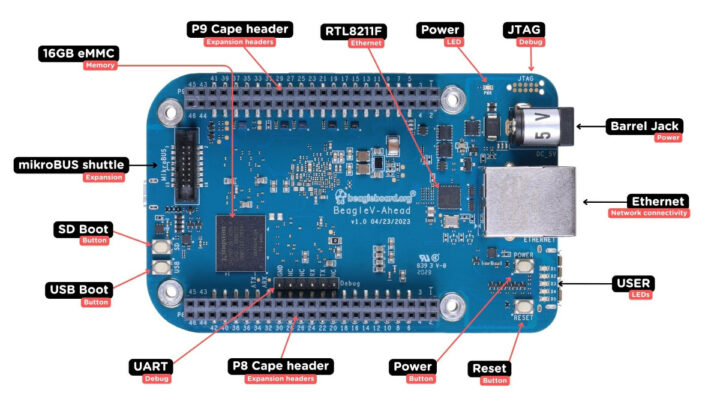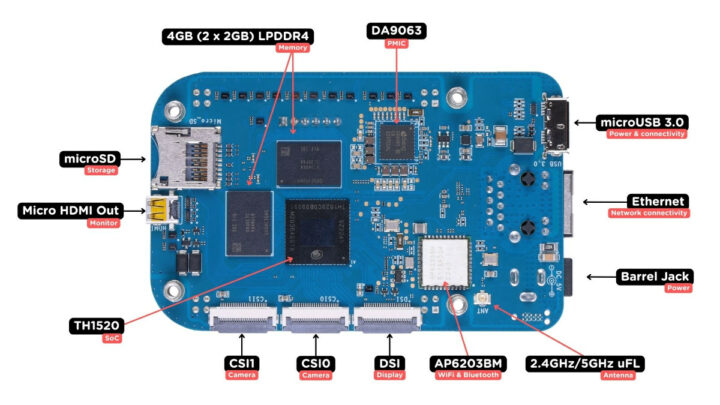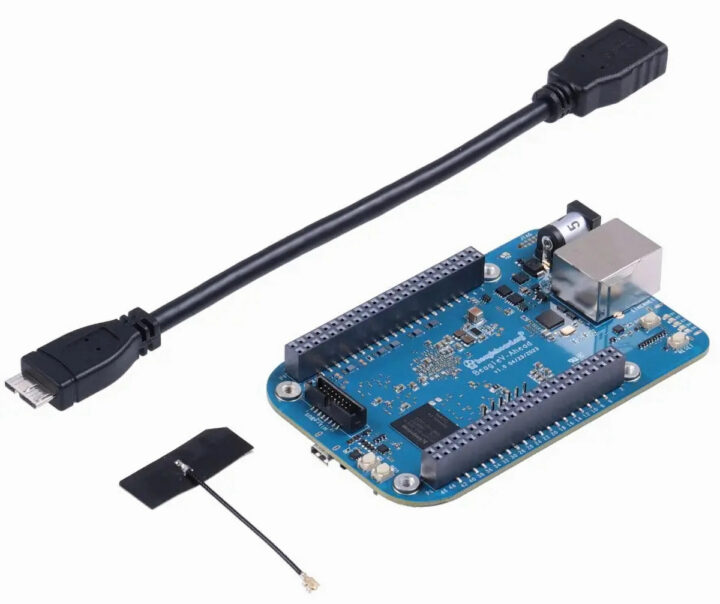Beagleboard.org Foundation’s BeagleV-Ahead is a single board computer powered by the T-Head TH1520 quad-core RISC-V processor and following the form factor of the popular BeagleBone Black board based on a Texas Instruments Sitara AM3359 single-core Arm Cortex-A8 processor.
The new board looks better in almost every way with a much faster processor, 4GB RAM, 16GB eMMC flash, Gigabit Ethernet, built-in WiFI and Bluetooth, a micro USB 3.0 port, micro HDMI video output up to 4Kp60, etc… and the same 80-pin headers as found on other BeagleBone boards. The main downside is that it comes at a significantly higher price as we’ll see further below.
BeagleV-Ahead specifications:
- SoC – Alibaba T-Head TH1520
- CPU – quad-core RISC-V Xuantie C910 (RV64GCV) processor @ up to 2.0 GHz, low power Xuantie E902 core
- GPU – Imagination BXM-4-64 GPU with OpenGL ES 3.2, OpenCL 2.0, Vulkan 1.2, 50.7GFLOPS
- DSP – Xuantie C906 audio DSP @ 800 MHz,
- AI accelerator – 4 TOPS NPU
- VPU – H.265/H.264 @ 4Kp75 video decoder, H.265/H.264 @ 4Kp40 video encoder
- System Memory – 4GB LPDDR4
- Storage – 16GB eMMC flash + microSD slot
- Video Output – micro HDMI port up to 4Kp60, MIPI DSI connector
- Audio – Digital audio output via HDMI
- Camera – 2x MIPI CSI connectors
- Networking
- Gigabit Ethernet RJ45 port via RTL8211F transceiver
- 2.4GHz/5GHz WiFi 4 up to 72 Mbps and Bluetooth 5.0 via Ampak AP6203BM and u.FL antenna connector
- USB – 1x micro USB 3.0 port
- Expansion
- P8 and P9 80-pin Cape headers for expansion boards (3.3V only)
- mikroBus shuttle connector for MikroElektronika click boards
- Debugging – 6-pin serial header
- Misc
- Indicators – Power, Ethernet, and 4x user’s LEDs
- Buttons – USB boot, SD Boot, Reset, and Power
- Power Supply
- 5V DC via power barrel jack
- DA9063 PMIC
- Dimensions – ~86.4 x 53.4 mm

 Ubuntu 23.04 and Yocto Linux images are provided for the board along with source code, and work-in-progress documentation can be found on beagleboard.org. Like other boards from the foundation, the BeagleV-Ahead is open-source with hardware design files available for download. You can also get support in the forums.
Ubuntu 23.04 and Yocto Linux images are provided for the board along with source code, and work-in-progress documentation can be found on beagleboard.org. Like other boards from the foundation, the BeagleV-Ahead is open-source with hardware design files available for download. You can also get support in the forums.
That’s another great development for the RISC-V ecosystem as a whole, and for the T-Head T1520 processor which is already used in the LicheePi 4A SBC and has plenty of commits in the upcoming Linux 6.5 release. That also means we now have a BeagleBone board with performance roughly equivalent to the Raspberry Pi 4 while keeping the many I/Os from the BeagleBone form factor. It does lack PRU support from the Texas Instruments SoC, but only time will tell how much it matters to various projects designed for the BeagleBone Black and compatible.
The BeagleV-Ahead RISC-V SBC is sold for $149 and up on distributors such as OKDo and Digi-Key. That’s a somewhat similar price to the $135 asked for the LicheePi 4A 8GB/32GB, but obviously much higher than the $55 Raspberry Pi 4 4GB (provided you can find it at that price). You’ll find more distributors and a few more details on the product page.

Jean-Luc started CNX Software in 2010 as a part-time endeavor, before quitting his job as a software engineering manager, and starting to write daily news, and reviews full time later in 2011.
Support CNX Software! Donate via cryptocurrencies, become a Patron on Patreon, or purchase goods on Amazon or Aliexpress







Nice to see that the Beagle family is still alive. One important aspect of the Beaglebone board was that it could run without any cooling solution, not even a heat sink, and used to drain very little power. As such you could power it far away over fantom power supplies or solar panels. I doubt this will be the case anymore, and I suspect that you’ll need at least a thermal plate under the board now.
Any benchmarks to compare this with Pi4
Not the BeagleV-Ahead directly, but you’ll find some benchmarks for the TH1520 (Lichee LM4A module) vs Pi 4 in the links below:
https://www.cnx-software.com/2022/12/14/sipeed-lm4a-t-head-th1520-risc-v-module-to-power-raspberry-pi-4-competitor-and-cluster-board/
https://github.com/ThomasKaiser/sbc-bench/blob/master/Results.md
It’s frightening that you need optimized toolchains to get good results. This reminds of the hell of PS2 MIPS toolchain with the Toshiba specific extensions. Never again, never…
Are these optimized toolchains upstreamed?
> It’s frightening that you need optimized toolchains to get good results.
Nobody knows what Sipeed’s marketing guys refer to as ‘optimized toolchain’ so until this is known I would call all their numbers just marketing BS.
Asides that Coremark is just another compiler benchmark. If you compare here https://www.eembc.org/viewer/?benchmark_seq=13461,13462 benchmark IDs 13461 and 13462 the 2nd system appears to be almost 4 times faster while it’s same HW, same SW, just different compiler flags.
The “TOTAL_DATA_SIZE” is probably important here as it “defines total size for data algorithms will operate on”. So if you can fit everything into cache with a smaller size this could help a lot…
They may be referring to the GCC with RISC-V vector extensions v0.71 which is out of tree and not accepted for upstream GCC as they said they’ll only accept released standard extensions and not pre-release ones. Just a guess.
If you compare with existing or fictional Lichee LM4A numbers you should keep in mind that TH1520 is advertised as 2.5 GHz capable (LM4 ran with 1.85 in the beginning and now 2 GHz), that maybe memory access can be improved (better boot BLOBs?) and that software support may improve over time. Stuff like using extensions…
Interesting test for a single-core CPU, which may depend a bit on RAM perf too:
> Interesting test for a single-core CPU, which may depend a bit on RAM perf too
The latter is easy to check, just echo performance|powersave on your Rock 5B to /sys/devices/platform/dmc/devfreq/dmc/governor and measure twice…
I was going to complain about their use of the horrible Micro-B USB3 connector as it’s horrible, but they seem to be using it as a HOST port with a special cable. That’s not a horrible idea. I mean it’s a horrible connector, but if you’re going to use a connector wrong, at least use a *strange* connector wrong. The intent is to minimize the chance of someone plugging something incompatable in and, since the USB-3 micro-B is so unusual, it makes a good choice. It’s sort of “two wrongs make a right”.
> the horrible Micro-B USB3 connector as it’s horrible, but they seem to be using it as a HOST port
Both host and OTG supported (see YT video at 1:17 and 2:29). Here in my device zoo four USB disk enclosures and an original UP Board use this crappy connector (though I would call it better than USB3-A due to the tiny SS contacts there that result in connection losses even when just gently bending USB cables)
Isn’t that the perfect usecase for USB-C?
I as TK have a couple of ext. HDs with this connector, it’s not the worst in my zoo…
Yeah why didn’t they just add at least one usb-c port on that thing!
I can see why they might want to avoid C as there’s more needed to support C. You would need switchable sense resistors, maybe something to speak on the CC lines.
I, too have a few things with this connector–old Samsung phone charger, a few HD enclosures from that akward time before C. It’s still strange and one of the rarer connectors I have. At least in the USB family.
Well if you don’t care about standards then what stops you from just using a USB-C for those signals you want?
Because you may still with to avoid problems. Using an unusual connector is a means to do that.
Has anyone found a TRM and datasheet on the TH1520?
I’m with you on this one, the moment this chip gets English TRM, this chip will have its proper judgement.
Is there no competitive RISC V by any well known western semiconductor manufacturer?
Are they still all with ARM?
Actually, deeply embedded CPUs are slowly being replaced by RISC-V, and not just those of 8051 kind. Even before ARM fiasco NoVideo has loudly (https://youtu.be/gg1lISJfJI0) switched to RISC-V for internal controllers, and Western Digital’s SweRV remains the largest commercialized-then-opened series of RISC-V cores, even if there is not many products using these.
@jean-luc
The specs, which you always helpfully list, lists the inclusion of an Ampak AP6203BM chip.
Given the amount of times they used “Open Source” and “RISC-V” in this product announcement, I want to ask a slightly tangential question: what progress is there with reverse engineering WiFi and Bluetooth for the RISC-V BL602/604?
This is the GitHub repo for the reverse-engineering effort:
https://github.com/pine64/bl602-re
The last commit for the README was last year, but the rest has not been updated for 2 years. So there does not seem to be any interest in this project.
Thanks for that.
I’d wondered if that was going to be the situation. It’s rather disappointing : it would be good to have open sourced RISC-V WiFi and Bluetooth.